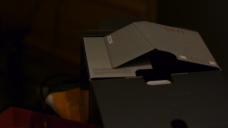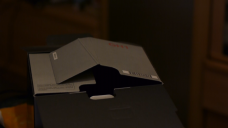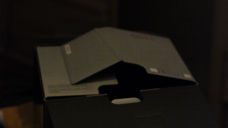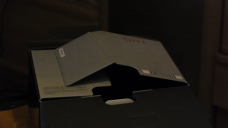
Do the 2011 GH1 models really have less FPN or is it balony?
-
i hope my 2011 model arrives in less than ten hours. Then I'm going to make a comparison between the 2011 and 2009 version.
-
just updated the ups-tracking of my new gh1. now it says scheduled delivery is june 6th :( although the package already arrived in my city.
so you have to wait a bit longer for a comparison... -
I tested to conclude what combination of body age (2010/2011), film mode, and recording mode produces the least FPN in a GH1.
Before you read or watch ANYTHING below, please keep in mind, I am not Zacuto, I've tried to run a pretty good test, but I'm not perfect, so if you doubt my testing below, please perform the same test and post your results.
My procedure:
I took my two bodies, one from pre-June 2010 and one I bought this week, hacked identically (Blackout-Powell 24p) and shot the exact same scene (an old computer lying around) with the exact same lighting, locking the tripod to ensure that both bodies would get the exact same shot.
If you're wondering how much light was actually there, know that every one of the clips you're about to see is brighter than the image I see with my eyes, and I have unusually good vision. I can barely read the darker parts of the text on the front of the computer in real life. So even though there's noise, this camera still does pretty well in the dark.
White balance differs slightly between the two bodies, I tried to manually match it, but it's not perfect.
Both cameras shot at 1080p24
All shots were with the same Panasonic 20mm f1.7 lens.
All Creative Movie Mode shots were shot at f1.7 with 1/30 shutter speed in order to mimic the exposure that Emory's settings would meter, since Emory's settings are based on Shutter Priority, not full manual.
When Emory's settings were used, they were identical to his settings linked in my signature, except in shutter priority, not Program. I held my hand in front of the lens before each shot in Emory's settings and hit AE lock, so that the camera metered the settings to the blackest image possible. When AE locked the camera reported f1.7, 1/30, and ISO 1600, which are identical to the Creative Movie Mode exposure settings. Therefore the only difference between the two modes was that Emory's uses the camera's metering and AE locking, whereas Creative Movie Mode was on full manual.
I tested two film modes. The first was Smooth with Contrast -2, Sharpness 0, Saturation 0, and NR -2. This film mode has been generally agreed upon (and in my opinion) as the mode that retains the highest dynamic range and most accurate color of any of the modes, and therefore is (in my opinion) the best for situations where light abounds. The other film mode used was Standard, +2, +2, 0, -2. I've worked this out as a good mode to attenuate noise and retain accurate color, with the Sharpness added to retain detail that's usually lost at high ISO. This is, in my opinion, the best settings for low light.
No color grading/correction was done.
My 2010 body has been heavily used, so in theory, its sensor might be more "burnt in" than the 2011 body.
The first half of the video is the raw results, the second half repeats those results split-screen between the old and new bodies to illustrate the difference in bodies.
Edited by import to DNxHD 220x (lossless 10-bit) in Avid Media Composer. Therefore the editing process was lossless, so any compression artifacts visible were the artifacts recorded by the cameras.
I've made a video that combines all the results side-by-side and split-screen that illustrates the differences well. However, since that video is encoded in DNxHD (lossless) the file is huge, and is still uploading. So the link below has all the original MTS files of the tests, renamed according to the settings used in each clip. Download them and see what you think. As soon as the compilation is done uploading it will also appear at the link below, so if you don't see it now, check back later. If you can't play the compilation test video, click on the imaginatively named "Install this if you can't play the video" folder and download the DNxHD codecs for Windows or Macs.
Go to http://files.coltonvideography.com/ to download the original test MTS files and my edited test results.
Please take a look and tell me what you think the results were. My conclusions are as follows:
1. Emory's settings definitely help, even though we/I really don't know how or why. Bravo, Emory!
2. The Standard settings have much less noise than Smooth, with the drawback of crushing some detail out of the blacks of the image.
3. Honestly I can't tell a huge difference between the bodies. The 2011 body seems to look better, but I don't know. There may be a difference but it is not huge. However, the settings I demonstrated can dramatically improve the FPN on both bodies.
In summary, I'd like your opinion on which body is better, but Emory's settings in Standard +2,+2,0,-2 were definitely the least noisy settings on both cameras.
Please tell me if you agree or disagree with my opinions as to the conclusions that can be drawn from this test. -
Thanks for sharing, I can't see any difference really, pretty much the same.
-
Difference can't be major. As it can come only from minor process improvements.
FPN in GH1 happens not because sensor is bad (all CMOS and MOS sensors have problems with FPN), it happens because necessary compensation algorithms are not implemented (in stills all works as it must work). -
here are some screengrabs of a comparison between 2009 and 2011 GH1. Decide for yourself if there's a difference. I did, too ;)
In order:
2009 iso400 http://personal-view.com/talks/uploads/FileUpload/bb/1071ecb9275a1e1429929254be6955.png
2011 iso400 http://personal-view.com/talks/uploads/FileUpload/46/8ac112081f322a73dc79849e288e10.png
2009 iso1600 http://personal-view.com/talks/uploads/FileUpload/53/65d11f43ca48f65ec419bf99868506.png
2011 iso1600 http://personal-view.com/talks/uploads/FileUpload/7f/a0f677c0112e00f955502c12a3511c.png
 iso400-2009.png1920 x 1080 - 848K
iso400-2009.png1920 x 1080 - 848K
 iso400-2011.png1920 x 1080 - 435K
iso400-2011.png1920 x 1080 - 435K
 iso1600-2009.png1920 x 1080 - 546K
iso1600-2009.png1920 x 1080 - 546K
 iso1600-2011.png1920 x 1080 - 997K
iso1600-2011.png1920 x 1080 - 997K -
When you are logged in, you can click on them. If this doesn't work: I've edited my post.
-
@CColton Kein Problem ;)
Start New Topic


Howdy, Stranger!
It looks like you're new here. If you want to get involved, click one of these buttons!
Categories
- Topics List23,990
- Blog5,725
- General and News1,353
- Hacks and Patches1,153
- ↳ Top Settings33
- ↳ Beginners256
- ↳ Archives402
- ↳ Hacks News and Development56
- Cameras2,367
- ↳ Panasonic995
- ↳ Canon118
- ↳ Sony156
- ↳ Nikon96
- ↳ Pentax and Samsung70
- ↳ Olympus and Fujifilm101
- ↳ Compacts and Camcorders300
- ↳ Smartphones for video97
- ↳ Pro Video Cameras191
- ↳ BlackMagic and other raw cameras116
- Skill1,960
- ↳ Business and distribution66
- ↳ Preparation, scripts and legal38
- ↳ Art149
- ↳ Import, Convert, Exporting291
- ↳ Editors191
- ↳ Effects and stunts115
- ↳ Color grading197
- ↳ Sound and Music280
- ↳ Lighting96
- ↳ Software and storage tips266
- Gear5,420
- ↳ Filters, Adapters, Matte boxes344
- ↳ Lenses1,582
- ↳ Follow focus and gears93
- ↳ Sound499
- ↳ Lighting gear314
- ↳ Camera movement230
- ↳ Gimbals and copters302
- ↳ Rigs and related stuff273
- ↳ Power solutions83
- ↳ Monitors and viewfinders340
- ↳ Tripods and fluid heads139
- ↳ Storage286
- ↳ Computers and studio gear560
- ↳ VR and 3D248
- Showcase1,859
- Marketplace2,834
- Offtopic1,319







